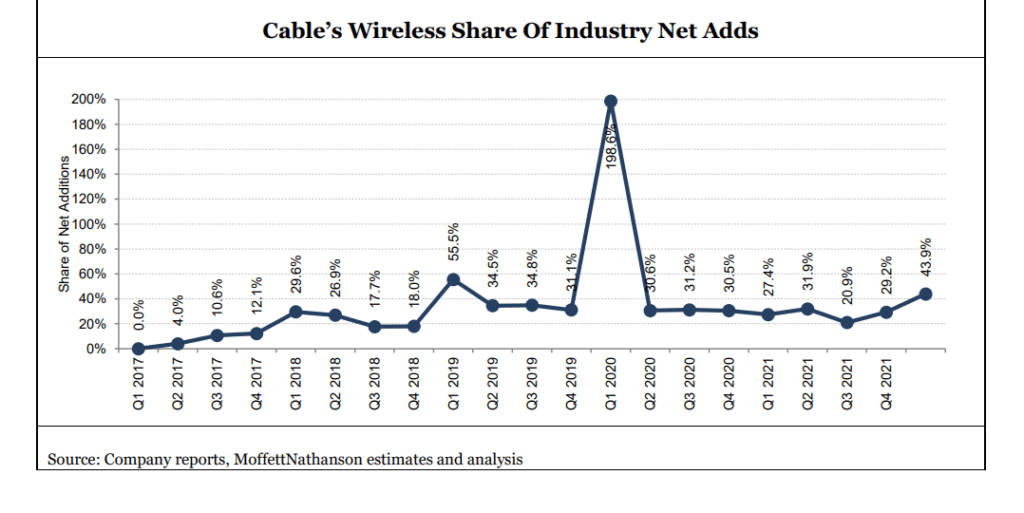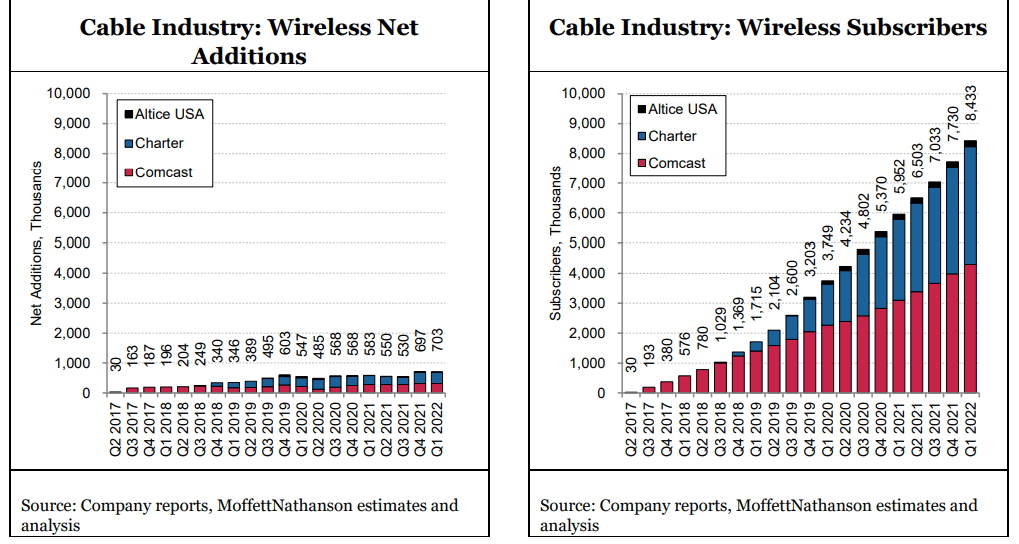Cable companies big gains in wireless threaten incumbent cellular telcos
by Craig Moffett of MoffettNathanson (edited by Alan J Weissberger)
Cable company’s 98% share of the wireless industry subscriber growth in Q1-2022 is a little known fact. And that does not include the free WiFi they offer to their customers, e.g. Xfinity WiFi and CableWiFi® (created through a collaboration of U.S. Cable and Internet Service Providers including Cox Communications, Optimum, Spectrum, and XFINITY. It allows each other’s eligible Internet customers free access to a collective network of more than 500,000 WiFi hotspots across the nation).
Until Q1-2022, Cable’s gains were almost exclusively from Comcast and Charter. Altice has now renegotiated its contract with T-Mobile, and they have moved to pricing that is even more aggressive than Comcast and Charter. [Interestingly, Altice’s contract allows Altice to name T-Mobile in their advertising as the underlying network, a contract term we’ve not seen before.]
Cox Communications, the nation’s third largest cable operator, is poised to join Cable’s ranks in offering wireless service, as well. The company won a Delaware Supreme Court decision in March, reversing a lower court decision that had previously upended their launch plans by finding they were bound to launch using T-Mobile’s instead of Verizon’s network, even if doing so was under less favorable contract terms. [They have not yet announced precise timing for their expected wireless relaunch.]
The pending addition of a wireless offering from Cox, and the more aggressive posture from Altice, will certainly compound the pressure Cable is putting on cellular telcos (e.g. Verizon, AT&T, T-Mobile, US Cellular, etc).
Cable’s 703K combined net additions were their best ever, and they have grown their subscriber base to 8.4M customers incredibly quickly. But those 8.4M subscribers still represent less than 3% market share of the U.S. market. They have a very long runway ahead.
Cable has achieved these gains without offering handset subsidies, something that seems inevitable sometime before the end of the year (Cable’s originally-BYOD subscribers will eventually demand new devices). Handset subsides from Cable, if and when they come, will only put more pressure on the cellular telco incumbents.
It is through this lens that one must view Verizon’s attempt to lead the industry to higher pricing [1.]. Subscriber growth is slowing. Cable’s share gains are accelerating. Cable has made clear that they do not plan to increase pricing. Nor does the industry price leader, T-Mobile. And Cable’s promotionality is likely to increase. That is a very tough backdrop against which to assume that price increases will “stick.”
Note 1. Verizon’s price increase, which will drop directly to the bottom line, will increase Verizon’s
service revenue and EBITDA by roughly $750M over the balance of the year, and by approximately $1.5B for next year, neither of which was contemplated in their previous guidance.
After accounting for 3G terminations, AT&T’s growth fell to just 360K net additions, leaving T-Mobile once again the industry’s fastest growing cellular telco. Not only is T-Mobile taking the industry’s largest share of gross additions – the best measure of customer choice – their churn rate is falling faster than any in the industry, as well, as they complete the transition of Sprint subscribers to their T-Mobile Magenta network. T-Mobile’s falling churn rate starves the industry gross add pool of what had been a critical source of “supply.”
The company is now most of the way through their migration of Sprint customers, and they have repeatedly suggested that churn on their Magenta network is the lowest in the industry, suggesting that churn should continue to fall, even if at a slightly slower pace going forward.
Only T-Mobile is growing ARPU at the moment, as more customers opt for higher value plans (Magenta Max). In contrast to the positive ARPU trend at T-Mobile, ARPU growth has been negative for eight straight quarters at AT&T (with the moderation in the rate of decline in Q1 largely attributable to the aforementioned extension of customer lives, which reduced amortization of historical promotional subsidies, and an easier comp against the same period last year).
ARPU growth at Verizon is not only negative, it is accelerating downward. For Verizon to post both negative subscriber growth and ARPU growth is a shock, and it points to the challenge facing the industry in getting ARPU increases to stick. Absent their wholesale contract with Cable, Verizon’s anemic 1.5% service revenue growth would be close to zero.
Verizon’s price increase comes at a time when industry unit growth is slowing, and at a time when Cable’s market share gains are accelerating both at the gross addition and net addition level. Without broad industry buy-in, and with subscribers looking harder to come by, we find it unlikely that Verizon’s price increases – even if AT&T does initially follow – will “stick.”
If wireless industry growth continues to decelerate, and Cable’s growth rate remains high, Cable’s share of growth will remain elevated, and the wireless industry will increasingly resemble a zero sum game for the Big Three incumbents, where one player’s gain (T-Mobile’s) will necessarily be another’s (Verizon’s and AT&T’s) loss. Huge losses at Dish Network’s Boost unit, and losses at U.S. Cellular, have helped soften the blow, but they are only so big. The pressure of falling industry growth and falling market share unavoidably falls on the cellular telco incumbents.
References:
Wireless Q1 2022: The Elephant in the Room, MoffettNathanson report to clients
MEF survey reveals top SD-WAN and SASE challenges
The Metro Ethernet Forum (MEF) conducted a survey which showed that the top SD-WAN and SASE challenges are focused on coping with operating a multi-vendor environment. That’s to be expected since there are no standards for multi-vendor interoperability for either of those technologies. MEF surveyed 36 worldwide service provider experts to obtain its results.
The complexity of operating and managing multi-vendor SD-WAN, integrating security options and defining end-to-end service level agreements (SLAs) were the top three challenges.

The top Secure Access Service Edge (SASE) challenges focus more on education and standardization. The top challenges service providers face with SASE are the lack of industry standards, customer education and migration, vendors not offering a complete solution and operating in a multi-vendor environment.

MEF’s research also shows that both SD-WAN and SASE markets are on track to hit analyst expectations. “The global SD-WAN services market should hit double-digit revenue growth in 2022, while most providers who offered SASE in 2021 expect 50%-plus revenue growth in 2022 due to a significant uptick in rollout of SASE services and features,” MEF Principal Analyst Stan Hubbard told SDxCentral via email.
All service providers surveyed already have elements of a SASE offering or plan to introduce a SASE solution in 2022, according to this MEF survey.
“The top SD-WAN and SASE service provider challenges are in line with expectations for the different stages of these markets, On the SD-WAN front, one of the biggest aggravations for providers is the complexity of operating a multivendor environment, which is primarily due to the absence of interoperability among SD-WAN technology vendors. Providers have told us that their need to develop and maintain expertise on various SD-WAN vendor solutions increases skills and training burdens, creates operational inefficiencies, and adds costs. The situation is made worse today because the terminology, architectures, performance metrics, etc., of vendors differ since they do not all adhere to common standards,” Hubbard wrote.
“The SASE services market is in its very early days, confusing, and full of a host of challenges related to customer education, customer migration, lack of industry standards, the lack of complete SASE vendor solutions and more. Multiple service providers agreed the organizational challenge of integrating networking and security is ‘huge’ for customers migrating to a SASE solution. As a large service provider stated, “SASE will be a failure without organizational change” within both customers and service providers,” Hubbard added.
References:
Shift from SDN to SD-WANs to SASE Explained; Network Virtualization’s important role
57% of European homes can now get FTTH/B internet access; >50% growth forecast over next 5 years
Europe has reached 200 million (M) homes that are now able to access FTTH/B services. That number is forecast to grow over 50 percent in the next five years, to more than 300 million homes passed, according to the latest research commissioned by the FTTH Council Europe. The new figures were released at its annual conference in Vienna, along with fiber subscriber numbers and research intro rural coverage.
The latest research by Idate for the council shows nearly 198.4 million homes were passed by FTTH or FTTB as of September 2021, up from 176.3 million a year earlier. The annual expansion was led by France (+4.3 M), the UK (+3.4 M), Germany (+2.4 M) and Italy (+1.5 M), all countries with a strong copper network footprint that previously held back fiber optic deployments.
The figures cover 39 countries across Europe and equal 57 percent of total households in the area, up by 4.5 percent points from a year earlier. In the 27 EU countries plus the UK, the coverage reached 48.5 percent of homes, up by 4.6 percent over the 12 months.
The number of subscribers on the fiber networks reached 96 million. The fastest growing markets in terms of new subscribers were France (+3.8 M), Spain (+1.2 M), Romania (+1 M), Italy (+820 K) and the UK (+765K). In total, 48.5 percent of households able to receive fibre services actually subscribed to the services, an increase of 3.6 percent in the network penetration rate. In the EU plus UK, take-up was at 52.4 percent, up 5.6 percent year-on-year.

Alternative operators still account for the majority of the FTTH/N coverage (57%), with incumbent operators taking 39 percent and 4 percent built by municipalities and utilities. Overall, there is a strong acceleration in fiber deployment, with a firm commitment to cover both urban and rural areas, the researchers said.
Idate also updated its five-year forecast for the FTTH/B market. It expects 199 million homes passed in 2027 in the EU+UK region and 309 million in the wider EU 39 region. Over the same period, the number of subscribers is expected to reach respectively 124 million and 190 million, equal to network penetration of over 62 percent in the EU and UK and more than 61 percent in the EU 39.
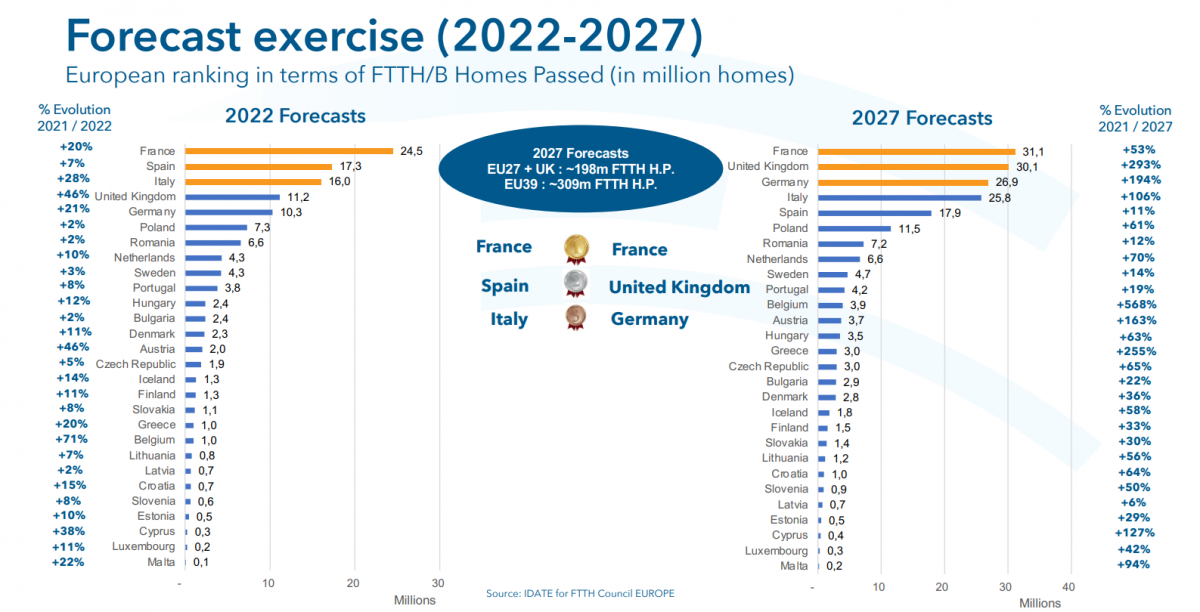
Further research shows that only 30 percent of rural inhabitants could enjoy fibre network access as of September 2021. Rural FTTH/B coverage is highest in Denmark (76%), Latvia (74%), Spain (66%), Romania (62%) and Luxembourg (55%). The report emphasized that immediate action should be oriented towards the rural regions, with increased public support through subsidies and partnerships to cover every European premise with high-speed broadband.
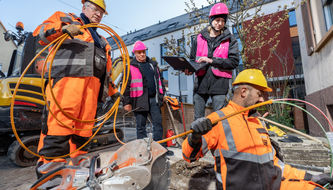
At the conference, the FTTH Council also announced several awards for contributions to the industry’s progress. UK wholesale operator CityFibre received the operator award; Jacek Wisniewski, CEO of Polish operator Nexera received the individual award; and Eurofiber CEO Alex Goldblum was winner of the Charles Kao award, named after the eponymous scientist who won a Nobel prize for physics for his research into fiber-optic communications.
References:
https://www.fibre-systems.com/news/europe-track-meet-connectivity-targets-rural-areas-gaining-focus
STC launches first 5G standalone (SA) core network in Bahrain via Huawei
STC Bahrain [1.] has announced the launch of the first 5G standalone (SA) core network in the kingdom using Huawei network equipment. This 5G SA network will enable new communication services for consumers and enterprises. Examples include high-resolution video, VR, AR, multimedia and online data communication.
The 5G standalone network will support the three ITU-R 5G Use Cases — enhanced mobile broadband (eMBB), ultra-reliable low latency communications (URLLC) and Massive Machine-Type Communications (mMTC) services. It will enable services in the public security, transportation, banking, consumer services, manufacturing, petroleum, port, healthcare and education sectors, among others.
5G SA supports multi-access edge computing (MEC) and uplink-centric broadband connectivity for both B2B and B2C services, STC said.

STC and Zain have deployed commercial 5G SA networks in Saudi Arabia, while STC has also launched 5G SA in Kuwait.
Note 1. STC Bahrain is a telecommunications service provider based in Bahrain. It is owned by the Saudi Telecom Company and started its commercial service in March 2010. The company is headquartered in Manama, Bahrain.
References:
http://www.abc-bahrain.com/News/1/334499
https://www.gsma.com/mobileeconomy/wp-content/uploads/2022/05/GSMA_MENA_ME2022_R_WebSingles.pdf
Lumen: DDOS attacks on the rise with telcos accounting for 76% in 1Q-2022
Telecommunications companies continued to be key targets for distributed denial of service (DDoS) attacks in Q1 2022, as the number of attacks jumped 32% year on year, according to a new Lumen report. Of the top 500 largest attacks, the telecom industry accounted for a whopping 76%. That compares to just 9% of the biggest attacks in Q1 2021.
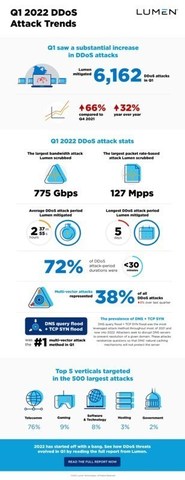
Key Findings:
- The number of DDoS attacks that Lumen scrubbed in Q1 2022 increased by 66% compared to Q4 2021, and by 32% compared to Q1 2021.
- Of the 500 largest attacks in Q1, 97% targeted the Telecommunications, Gaming, Software and Technology, Hosting, and Government verticals.
- Lumen protected one organization from more than 1,300 DDoS attacks – more than 20% of the total number of attacks scrubbed during the entire quarter.
- The same organization accounted for the largest bandwidth attack that has ever passed through Lumen’s scrubbing centers at 775 Gbps.
“Our first-quarter data shows just how important it is for businesses to maintain solid cyber defense strategies,” said Beth Kohler, senior director of Security Product Management for Lumen. “Anyone can be the target of a large attack at any time. Even a few minutes of downtime can cause serious damage to a company’s operations, revenue and reputation. Because the highly targeted customer uses Lumen’s Always-On DDoS Mitigation Service with Rapid Threat Defense, many attacks are blocked before they can do any damage. We can only imagine the harm these criminals could have caused to our customer (and their customers) had these attacks succeeded.”
Mark Dehus, director of threat intelligence for Lumen Black Lotus Labs, told Fierce the growing size of both the bandwidth and packet attacks is significant because such threats affect the network in different ways.
“Bandwidth per second can just overwhelm and flood a particular link or connection, especially if done in a certain way, such that nothing else can make it through that pipe,” he explained. “Instead of saturating the actual bandwidth that can be transmitted through the pipe, with packets per second you can overwhelm the gear that’s doing the processing itself.”
That includes things like CPUs and routers and other equipment tasked with helping maintain a firewall, Dehus said. “So, the continued growth we’re seeing on both fronts is alarming and concerning,” he added.
Other Findings:
- The largest packet rate-based attack scrubbed in Q1 was 127 Mpps, which was more than double what Lumen mitigated in Q4.
- The longest DDoS attack period Lumen mitigated for an individual customer in Q1 2022 lasted five days.
- Thirty two percent of all DDoS mitigations were single-vector, TCP SYN flooding attacks. This indicates that many actors are still relying on simple, tried-and-true attack methods.
- Multi-vector attacks seem to be the tactic of choice for the gaming and telecommunications sectors represented 38% of all DDoS mitigations.
References:
https://tinyurl.com/Q1DDoSReport
https://www.fiercetelecom.com/telecom/single-telecom-accounted-20-ddos-attacks-q1-lumen-finds
https://www.fiercetelecom.com/telecom/lumen-finds-a-third-largest-ddos-attacks-q3-targeted-telecoms
Viettel Group and Qualcomm collaborate on 5G Radio Unit with massive MIMO
Vietnam’s Viettel Group and Qualcomm Technologies, Inc. announced plans to collaborate and develop a next-generation 5G Radio Unit (RU) with massive MIMO capabilities and distributed units (DUs). This focuses on helping to expedite the development and roll-out of 5G network infrastructure and services in Vietnam and globally.
Using the Qualcomm® X100 5G RAN Accelerator Card and Massive MIMO Qualcomm® QRU100 5G RAN Platform combined with its own advanced hardware and software systems, Viettel expects to accelerate the development and commercialization of high-performance Open RAN massive MIMO solutions, which simplify network deployment and lower total cost of ownership (TCO).
Viettel is one of four global partners trusted and selected by Qualcomm to participate in the development and application of this new 5G chipset of Qualcomm. According to Qualcomm, the partnership will help advance the cellular ecosystem and accelerate the innovation cycle.
Present in 11 countries and territories, the digital services provided by Viettel serves a customer base of more than 270 million people worldwide from Asia, Africa and the Americas. Viettel has successfully tested 5G in 15 provinces and cities across Vietnam.

“Viettel has been a pioneer in adopting new telecommunications technologies including 5G. We are delighted to have Qualcomm Technologies as a key technology provider in our 5G gNodeB project,” said Nguyen Vu Ha, general director, Viettel High Technology. “This collaboration between Qualcomm Technologies and Viettel Group will be the cornerstone of Vietnam’s national strategy for Made in Vietnam 5G infrastructure.”
“Qualcomm Technologies, as a global technology leader in 5G, is looking forward to collaborating with Viettel for the development of Open RAN solutions that will establish the foundation for Vietnam’s next-generation of wireless networks,” said Durga Malladi, senior vice president and general manager, Cellular Modems and Infrastructure, Qualcomm Technologies, Inc.
About Viettel:
Viettel has built a large 4G telecommunications infrastructure covering 97% of Vietnam population and has become a pioneer in 5G adoption in Vietnam. Viettel’s 5G services are available in 16 cities and provinces in Vietnam to date. Viettel develops full network elements including Devices, Radio Access Network (RAN), Transmission Network, and Core Network which are forming a strong foundation for digital society.
About Qualcomm:
Qualcomm is the world’s leading wireless technology innovator and the driving force behind the development, launch, and expansion of 5G. Qualcomm Technologies, Inc., a subsidiary of Qualcomm Incorporated, operates, along with its subsidiaries, substantially all of our engineering, research and development functions, and substantially all of our products and services businesses, including our QCT semiconductor business.
References:
https://viettel-com-vn.translate.goog/vi/?_x_tr_sl=vi&_x_tr_tl=en&_x_tr_hl=en&_x_tr_pto=sc
CELLSMART: 5G upload speeds are insufficient for industrial/enterprise applications
Research conducted by CELLSMART, a division of French managed services provider SmartCIC, has found that 5G upload speeds are in many cases insufficient to support data transfer for enterprise applications. The Global Cellular Performance Survey was based on independent field tests conducted by 2,536 telecoms network engineers in 51 countries to capture network performance data and then analyzed by the CELLSMART team.
The CELLSMART Global Cellular Performance Survey collects data from telecoms network engineers working in the field to provide an up-to-date snap shot of actual performance across cellular technologies. It is using the data it collects in its planning, network selection and service development and monitoring for fixed wireless enterprise customers.
Top 5 Metro Markets – 5G Average Download Speed
• Cannes (France)
• Munich (Germany)
• Nashville (US)
• Oslo (Norway)
• Singapore
“The research shows how MNOs have prioritized 5G download speeds in their initial rollouts and now there’s an opportunity to focus on enterprise demand for rapid upstream data transfer. 5G networks are showing upload speeds that are 13% of their download speeds while 4G has a balanced download/upload symmetry with 36%. Based on the research sample, we saw 5G delivering higher latency than 4G in some cases. This may be due to a number of the 5G tests being run on low-band networks. Where results have been taken in areas with mmWave, there are dramatically different results including downloads in excess of 800mbps, uploads in excess of 250mbps and latencies of sub 10ms,” said Toby Forman, CEO at SmartCIC.

For capturing network performance data, speed tests were run by 2,536 telecoms network engineers across 51 countries in 331 unique locations globally. Each engineer conducted the tests independently in the field and submitted result anonymously between March 25, 2022 and May 6, 2022. Data samples were collected from Africa, Asia, Australia, the Americas and Europe. The CELLSMART team did the data analysis.
Top 5 Mobile Network Operators – Maximum Download Speeds (All Technologies)
• du (UAE)
• Telia (Sweden)
• Deutsche Telekom (Germany)
• EE (UK)
• Singtel (Singapore)
However, upload speeds were on average only 31.27 Mbps – just 55% better than the 4G global average.
“We went out to our global network of 25,000 engineers and asked them to log network performance wherever they were operating. Over time, as we see more results added to our database and we’ll be able to provide an accurate and evolving snapshot of how cellular technologies are performing in the field. This initial cut of data is just the start of the process. As we begin to see greater density of results globally we will those into insights for our customers and the broader market,” said Forman. “We did this because this information simply didn’t exist on a global scale and we believe the market needs intelligent cellular solutions,” he added.
References:
Orange Poland explores 5G drone management while Verizon shuts down its drone subsidiary
Orange Poland is researching the possibilities for using 5G technology for the management of drones. These activities are being done by its R&D unit – the 5G Lab. Almost 200,000 drone users are currently registered in the country. Latvian operator LMT is also doing research on the same topic. However, Verizon has notified customers that it is closing down Skyward – its drone software company.
……………………………………………………………………………………………………………………………………………..

Separately, Polish telecommunications regulator UKE issued 119 decisions clearing testing of 5G technology on the 700 MHz, 800 MHz, 3.5 GHz and 26 GHz bands in 2021, reports Telko.in.
Orange Poland and P4 (Play) tested 5G the most. The tests were mainly carried out on the 3.5 GHz band in major cities, such as Warsaw and Lodz, and Play also tested 5G on the 26 GHz band in Torun.
Polkomtel, trading under the Plus brand, was the only among major Polish mobile operators which didn’t apply for 5G testing in 2021.
References:
https://www.telecompaper.com/news/orange-poland-researches-use-of-5g-for-drone-management–1424164
https://www.totaltele.com/513296/Drone-company-Skyward-crash-lands-as-Verizon-pulls-plug
https://www.telecompaper.com/news/poland-approves-119-5g-tests-in-2021–1423392
Summary of EU report: cybersecurity of Open RAN
The EU has published a report on the cybersecurity of Open RAN, a 4G/5G (maybe even 2G?) network architecture the European Commission says will provide an alternative way of deploying the radio access part of 5G networks over the coming years, based on open interfaces. The EU noted that while Open RAN architectures create new opportunities in the marketplace, they also raise important security challenges, especially in the short term.
“It will be important for all participants to dedicate sufficient time and attention to mitigate such challenges, so that the promises of Open RAN can be realized,” the report said.
The report found that Open RAN could bring potential security opportunities, provided certain conditions are met. Namely, through greater interoperability among RAN components from different suppliers, Open RAN could allow greater diversification of suppliers within networks in the same geographic area. This could contribute to achieving the EU 5G Toolbox recommendation that each operator should have an appropriate multi-vendor strategy to avoid or limit any major dependency on a single supplier.
Open RAN could also help increase visibility of the network thanks to the use of open interfaces and standards, reduce human errors through greater automation, and increase flexibility through the use of virtualisation and cloud-based systems.
However, the Open RAN concept still lacks maturity, which means cybersecurity remains a significant challenge. Especially in the short term, by increasing the complexity of networks, Open RAN could exacerbate certain types of security risks, providing a larger attack surface and more entry points for malicious actors, giving rise to an increased risk of misconfiguration of networks and potential impacts on other network functions due to resource sharing.
The report added that technical specifications, such as those developed by the O-RAN Alliance, are not yet sufficiently secure by design. This means that Open RAN could lead to new or increased critical dependencies, for example in the area of components and cloud.
The EU recommended the use of regulatory powers to monitor large-scale Open RAN deployment plans from mobile operators and if needed, restrict, prohibit or impose specific requirements or conditions for the supply, large-scale deployment and operation of the Open RAN network equipment.
Technical controls such as authentication and authorization could be reinforced and a risk profile assessed for Open RAN providers, external service providers related to Open RAN, cloud service/infrastructure providers and system integrators. The EU added that including Open RAN components into the future 5G cybersecurity certification scheme, currently under development, should happen at the earliest possible stage.
Following up on the coordinated work already done at EU level to strengthen the security of 5G networks with the EU Toolbox on 5G Cybersecurity, Member States have analysed the security implications of Open RAN.
Margrethe Vestager, Executive Vice-President for a Europe Fit for the Digital Age, said: “Our common priority and responsibility is to ensure the timely deployment of 5G networks in Europe, while ensuring they are secure. Open RAN architectures create new opportunities in the marketplace, but this report shows they also raise important security challenges, especially in the short term. It will be important for all participants to dedicate sufficient time and attention to mitigate such challenges, so that the promises of Open RAN can be realised.”
Thierry Breton, Commissioner for the Internal Market, added: “With 5G network rollout across the EU, and our economies’ growing reliance on digital infrastructures, it is more important than ever to ensure a high level of security of our communication networks. That is what we did with the 5G cybersecurity toolbox. And that is what – together with the Member States – we do now on Open RAN with this new report. It is not up to public authorities to choose a technology. But it is our responsibility to assess the risks associated to individual technologies. This report shows that there are a number of opportunities with Open RAN but also significant security challenges that remain unaddressed and cannot be underestimated. Under no circumstances should the potential deployment in Europe’s 5G networks of Open RAN lead to new vulnerabilities.”
Guillaume Poupard, Director General of France’s National Cyber Security Agency (ANSSI), said: “After the EU Toolbox on 5G Cybersecurity, this report is another milestone in the NIS Cooperation Group’s effort to coordinate and mitigate the security risks of our 5G networks. This in-depth security analysis of Open RAN contributes to ensuring that our common approach keeps pace with new trends and related security challenges. We will continue our work to jointly address those challenges.”
Finally, a technology-neutral regulation to foster competition should be maintained., with EU and national funding for 5G and 6G research and innovation, so that EU players can compete on a level playing field.
References:
https://ec.europa.eu/commission/presscorner/detail/en/IP_22_2881
https://digital-strategy.ec.europa.eu/en/library/cybersecurity-open-radio-access-networks
New developments from satellite internet companies challenging SpaceX and Amazon Kuiper
Satellite internet companies making news in recent days include Telesat, Globalstar, Intelsat, EchoStar, and Gogo:
- Telesat reduced the size of its planned low-Earth orbit (LEO) satellite constellation for global Internet services. The company still plans to spend a total of $5 billion on its Lightspeed effort, but now plans to operate a total of 188 satellites instead of 298.
- Globalstar signed a term sheet with a “large, global customer” to start deploying some of its spectrum for terrestrial use in the U.S. and elsewhere. “We continue to believe Apple is the most probable wholesale satellite capacity customer but await further clues, with iPhone 14 release later this year a potential catalyst,” the financial analysts at B. Riley Securities wrote in a note to investors.
- Intelsat, having recently emerged from bankruptcy, installed a number of new executives from defense contractor Raytheon, including CEO David Wajsgras. The company remains locked in a contentious legal battle with SES over proceeds from the FCC’s massive C-band auction for 5G spectrum.
- EchoStar announced that the launch of its planned Jupiter 3 satellite will be delayed until next year. A number of other satellite companies have reported similar problems amid a tightening supply of satellite launch providers. EchoStar also has a relatively new CEO in Hamid Akhavan. Further, Anders Johnson, who was leading the integration of EchoStar’s operations with 5G, is leaving the company. However, the financial analysts at Raymond James believe that Johnson’s departure doesn’t necessarily signal a step back from EchoStar’s broader plans to integrate its satellites into terrestrial networks. “We think hybrid solutions will play a major role in EchoStar’s future, including geostationary (GEO), LEO and terrestrial 5G connections, and we think S-band [spectrum] will also play a role,” they wrote. Finally, Gogo announced it’s still on track to deploy a terrestrial 5G network in the US by the end of this year. The network will beam Internet connections to airplanes.
- Gogo executives reiterated their interest in adding LEO capabilities to the company’s overall networking offerings, though they stopped short of making any firm announcements.
These developments help show that a wide range of companies – beyond big-name satellite internet companies like SpaceX and Amazon Kuiper – are heavily investing in space communications. It’s worth noting that an array of big name telecom companies have been inking agreements with satellite operators.
For example, AT&T has an agreement with LEO operator OneWeb; Verizon has a similar deal with LEO hopeful Amazon; and Vodafone is working with upstart AST SpaceMobile to connect regular, existing smartphones to satellites.
References:


